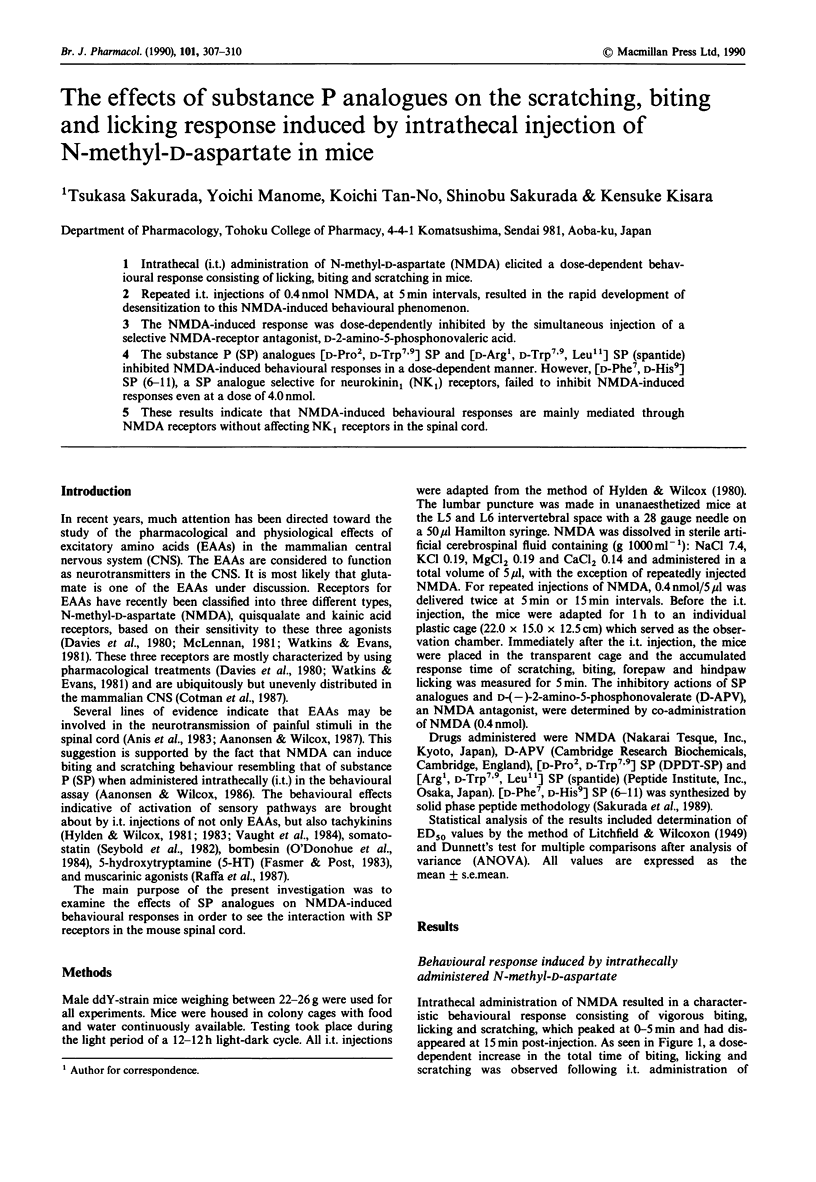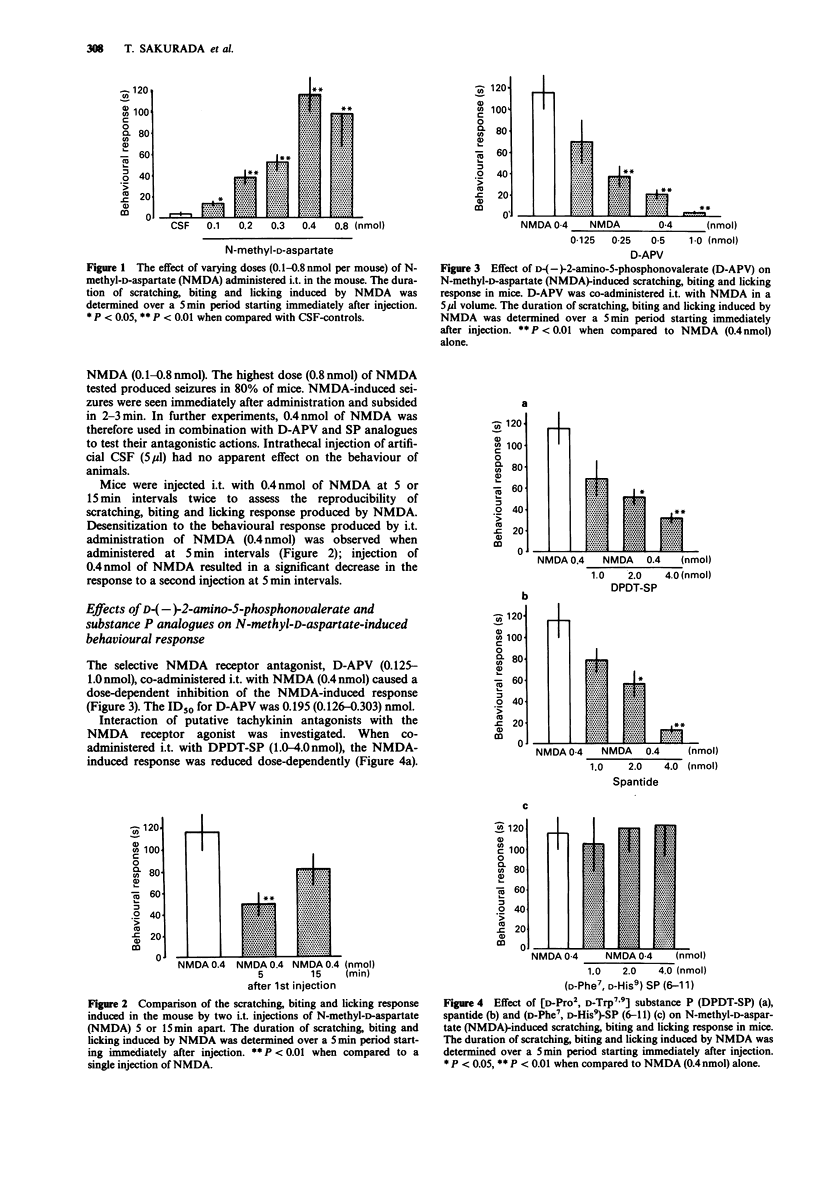Abstract
1. Intrathecal (i.t.) administration of N-methyl-D-aspartate (NMDA) elicited a dose-dependent behavioural response consisting of licking, biting and scratching in mice. 2. Repeated i.t. injections of 0.4 nmol NMDA, at 5 min intervals, resulted in the rapid development of desensitization to this NMDA-induced behavioural phenomenon. 3. The NMDA-induced response was dose-dependently inhibited by the simultaneous injection of a selective NMDA-receptor antagonist, D-2-amino-5-phosphonovaleric acid. 4. The substance P (SP) analogues [D-Pro2, D-Trp7,9] SP and [D-Arg1, D-Trp7,9, Leu11] SP (spantide) inhibited NMDA-induced behavioural responses in a dose-dependent manner. However, [D-Phe7, D-His9] SP (6-11), a SP analogue selective for neurokinin1 (NK1) receptors, failed to inhibit NMDA-induced responses even at a dose of 4.0 nmol. 5. These results indicate that NMDA-induced behavioural responses are mainly mediated through NMDA receptors without affecting NK1 receptors in the spinal cord.
Full text
PDF



Selected References
These references are in PubMed. This may not be the complete list of references from this article.
- Aanonsen L. M., Wilcox G. L. Phencyclidine selectively blocks a spinal action of N-methyl-D-aspartate in mice. Neurosci Lett. 1986 Jun 18;67(2):191–197. doi: 10.1016/0304-3940(86)90396-4. [DOI] [PubMed] [Google Scholar]
- Akerman B., Rosell S., Folkers K. Intrathecal (D-Pro2, D-Trp7,9)-SP elicits hypoalgesia and motor blockade in the rat and antagonizes noxious responses induced by substance P. Acta Physiol Scand. 1982 Apr;114(4):631–633. doi: 10.1111/j.1748-1716.1982.tb07036.x. [DOI] [PubMed] [Google Scholar]
- Anis N. A., Berry S. C., Burton N. R., Lodge D. The dissociative anaesthetics, ketamine and phencyclidine, selectively reduce excitation of central mammalian neurones by N-methyl-aspartate. Br J Pharmacol. 1983 Jun;79(2):565–575. doi: 10.1111/j.1476-5381.1983.tb11031.x. [DOI] [PMC free article] [PubMed] [Google Scholar]
- DeLander G. E., Wahl J. J. In vivo characterization of phencyclidine/sigma agonist-mediated inhibition of nociception. Eur J Pharmacol. 1989 Jan 10;159(2):149–156. doi: 10.1016/0014-2999(89)90699-7. [DOI] [PubMed] [Google Scholar]
- Fasmer O. B., Post C. Behavioural responses induced by intrathecal injection of 5-hydroxytryptamine in mice are inhibited by a substance P antagonist, D-Pro2, D-Trp7,9-substance P. Neuropharmacology. 1983 Dec;22(12A):1397–1400. doi: 10.1016/0028-3908(83)90230-7. [DOI] [PubMed] [Google Scholar]
- Hylden J. L., Wilcox G. L. Intrathecal morphine in mice: a new technique. Eur J Pharmacol. 1980 Oct 17;67(2-3):313–316. doi: 10.1016/0014-2999(80)90515-4. [DOI] [PubMed] [Google Scholar]
- Hylden J. L., Wilcox G. L. Intrathecal opioids block a spinal action of substance P in mice: functional importance of both mu- and delta-receptors. Eur J Pharmacol. 1982 Dec 17;86(1):95–98. doi: 10.1016/0014-2999(82)90403-4. [DOI] [PubMed] [Google Scholar]
- Hylden J. L., Wilcox G. L. Intrathecal substance P elicits a caudally-directed biting and scratching behavior in mice. Brain Res. 1981 Jul 27;217(1):212–215. doi: 10.1016/0006-8993(81)90203-1. [DOI] [PubMed] [Google Scholar]
- Hökfelt T., Vincent S., Hellsten L., Rosell S., Folkers K., Markey K., Goldstein M., Cuello C. Immunohistochemical evidence for a "neurotoxic" action of (D-Pro2, D-Trp7,9)-substance P, an analogue with substance P antagonistic activity. Acta Physiol Scand. 1981 Dec;113(4):571–573. doi: 10.1111/j.1748-1716.1981.tb06943.x. [DOI] [PubMed] [Google Scholar]
- Larson A. A. Desensitization to intrathecal substance P in mice: possible involvement of opioids. Pain. 1988 Mar;32(3):367–374. doi: 10.1016/0304-3959(88)90049-8. [DOI] [PubMed] [Google Scholar]
- Matsumura H., Sakurada T., Hara A., Kuwahara H., Ando R., Sakurada S., Kisara K. Intrathecal substance P analogue causes motor dysfunction in the rat. Neuropharmacology. 1985 Aug;24(8):811–813. doi: 10.1016/0028-3908(85)90017-6. [DOI] [PubMed] [Google Scholar]
- Matsumura H., Sakurada T., Hara A., Sakurada S., Kisara K. Characterization of the hyperalgesic effect induced by intrathecal injection of substance P. Neuropharmacology. 1985 May;24(5):421–426. doi: 10.1016/0028-3908(85)90027-9. [DOI] [PubMed] [Google Scholar]
- McLennan H. On the nature of the receptors for various excitatory amino acids in the mammalian central nervous system. Adv Biochem Psychopharmacol. 1981;27:253–262. [PubMed] [Google Scholar]
- Moochhala S. M., Sawynok J. Hyperalgesia produced by intrathecal substance P and related peptides: desensitization and cross desensitization. Br J Pharmacol. 1984 Jun;82(2):381–388. doi: 10.1111/j.1476-5381.1984.tb10773.x. [DOI] [PMC free article] [PubMed] [Google Scholar]
- O'Donohue T. L., Massari V. J., Pazoles C. J., Chronwall B. M., Shults C. W., Quirion R., Chase T. N., Moody T. W. A role for bombesin in sensory processing in the spinal cord. J Neurosci. 1984 Dec;4(12):2956–2962. doi: 10.1523/JNEUROSCI.04-12-02956.1984. [DOI] [PMC free article] [PubMed] [Google Scholar]
- Post C., Folkers K. Behavioural and antinociceptive effects of intrathecally injected substance P analogues in mice. Eur J Pharmacol. 1985 Jul 31;113(3):335–343. doi: 10.1016/0014-2999(85)90081-0. [DOI] [PubMed] [Google Scholar]
- Post C., Paulsson I. Antinociceptive and neurotoxic actions of substance P analogues in the rat's spinal cord after intrathecal administration. Neurosci Lett. 1985 Jun 12;57(2):159–164. doi: 10.1016/0304-3940(85)90056-4. [DOI] [PubMed] [Google Scholar]
- Raffa R. B., Mathiasen J. R., Goode T. L., Vaught J. L. Evidence that reciprocal hindlimb scratching elicited in mice by intrathecal administration of muscarinic agonists is mediated through M1 type receptors. Life Sci. 1987 Oct 12;41(15):1831–1836. doi: 10.1016/0024-3205(87)90702-8. [DOI] [PubMed] [Google Scholar]
- Rodriguez R. E., Salt T. E., Cahusac P. M., Hill R. G. The behavioural effects of intrathecally administered [D-PRO2, D-TRP7,9]-substance P, an analogue with presumed antagonist actions, in the rat. Neuropharmacology. 1983 Feb;22(2):173–176. doi: 10.1016/0028-3908(83)90005-9. [DOI] [PubMed] [Google Scholar]
- Sakurada T., Hara A., Matsumura H., Yamada H., Sakurada S., Kisara K. A substance P analogue reduces amino acid contents in the rat spinal cord. Pharmacol Toxicol. 1990 Jan;66(1):75–76. doi: 10.1111/j.1600-0773.1990.tb00708.x. [DOI] [PubMed] [Google Scholar]
- Sakurada T., Kuwahara H., Sakurada S., Kisara K., Ohba M., Munekata E. Behavioural assessment as substance P antagonists in mice. Neuropeptides. 1987 Apr;9(3):197–206. doi: 10.1016/0143-4179(87)90039-4. [DOI] [PubMed] [Google Scholar]
- Sakurada T., Takahashi K., Sakurada S., Kisara K., Folkesson R., Terenius L. Enkephalins interact with substance P-induced aversive behaviour in mice. Brain Res. 1988 Feb 23;442(1):191–194. doi: 10.1016/0006-8993(88)91451-5. [DOI] [PubMed] [Google Scholar]
- Sakurada T., Yamada T., Sakurada S., Kisara K., Ohba M. Substance P analogues containing D-histidine antagonize the behavioural effects of intrathecally co-administered substance P in mice. Eur J Pharmacol. 1989 Dec 19;174(2-3):153–160. doi: 10.1016/0014-2999(89)90307-5. [DOI] [PubMed] [Google Scholar]
- Salt T. E., De Vries G. J., Rodriguez R. E., Cahusac P. M., Morris R., Hill R. G. Evaluation of (D-Pro2, D-Trp7,9)-substance P as an antagonist of substance P responses in the rat central nervous system. Neurosci Lett. 1982 Jun 30;30(3):291–295. doi: 10.1016/0304-3940(82)90415-3. [DOI] [PubMed] [Google Scholar]
- Seybold V. S., Hylden J. L., Wilcox G. L. Intrathecal substance P and somatostatin in rats: behaviors indicative of sensation. Peptides. 1982 Jan-Feb;3(1):49–54. doi: 10.1016/0196-9781(82)90141-3. [DOI] [PubMed] [Google Scholar]
- Stoppini L., Baertschi A. J., Mathison R., Barja F. Neural actions of several substance P antagonists in the rat spinal cord. Neurosci Lett. 1983 Jun 30;37(3):279–283. doi: 10.1016/0304-3940(83)90444-5. [DOI] [PubMed] [Google Scholar]
- Takahasi K., Sakurada T., Sakurada S., Kuwahara H., Yonezawa A., Ando R., Kisara K. Behavioural characterization of substance P-induced nociceptive response in mice. Neuropharmacology. 1987 Sep;26(9):1289–1293. doi: 10.1016/0028-3908(87)90089-x. [DOI] [PubMed] [Google Scholar]
- Vaught J. L., Post L. J., Jacoby H. I., Wright D. Tachykinin-like central activity of neuromedin K in mice. Eur J Pharmacol. 1984 Aug 17;103(3-4):355–357. doi: 10.1016/0014-2999(84)90499-0. [DOI] [PubMed] [Google Scholar]
- Vaught J. L., Scott R. Interactions of substance P antagonists with serotonin in the mouse spinal cord. Peptides. 1988 Jul-Aug;9(4):909–913. doi: 10.1016/0196-9781(88)90140-4. [DOI] [PubMed] [Google Scholar]
- Watkins J. C., Evans R. H. Excitatory amino acid transmitters. Annu Rev Pharmacol Toxicol. 1981;21:165–204. doi: 10.1146/annurev.pa.21.040181.001121. [DOI] [PubMed] [Google Scholar]
- Wiesenfeld-Hallin Z., Duranti R. D-Arg1, D-Trp7,9, Leu11-substance P (spantide) does not antagonize substance P-induced hyperexcitability of the nociceptive flexion withdrawal reflex in the rat. Acta Physiol Scand. 1987 Jan;129(1):55–59. doi: 10.1111/j.1748-1716.1987.tb08039.x. [DOI] [PubMed] [Google Scholar]
- Yasphal K., Wright D. M., Henry J. L. Substance P reduces tail-flick latency: implications for chronic pain syndromes. Pain. 1982 Oct;14(2):155–167. doi: 10.1016/0304-3959(82)90096-3. [DOI] [PubMed] [Google Scholar]


